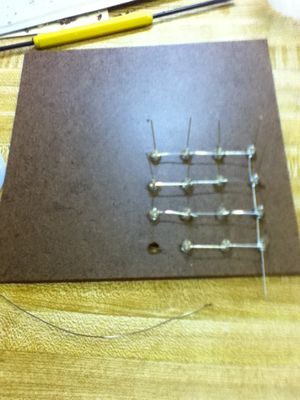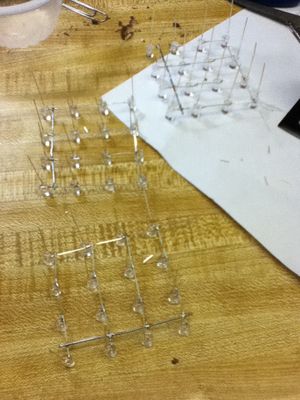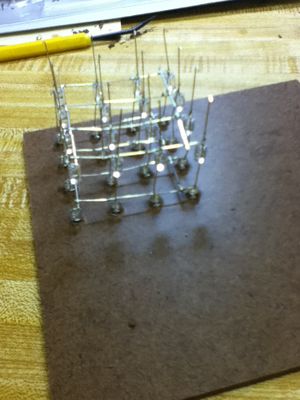Difference between revisions of "Ed Powell"
From WLCS
| Line 8: | Line 8: | ||
* A breadboard will be used to aid in learning the instruction set and to ease programming | * A breadboard will be used to aid in learning the instruction set and to ease programming | ||
** An ATmega 168 will be used in addition to the ATmega 16 while the instruction set is being learned | ** An ATmega 168 will be used in addition to the ATmega 16 while the instruction set is being learned | ||
| + | |||
'''Progress:''' | '''Progress:''' | ||
| Line 18: | Line 19: | ||
** The breadboard should be used so circuits can be made, tested, and then disassembled | ** The breadboard should be used so circuits can be made, tested, and then disassembled | ||
** A blink LED program has been executed - Ongoing | ** A blink LED program has been executed - Ongoing | ||
| − | *** | + | *** Wire the circuit and load the program onto the micro-controller - ✓ |
| + | *** Test the circuit and make sure the LED blinks - Needs Debugging | ||
| + | ** Other beginner programs should be made and tested - Ongoing | ||
* All of the necessary parts to build the cube have been purchased (see list below) - ✓ | * All of the necessary parts to build the cube have been purchased (see list below) - ✓ | ||
* All parts have been soldered onto the proto-board and the circuitry has been wired - Ongoing | * All parts have been soldered onto the proto-board and the circuitry has been wired - Ongoing | ||
| − | ** The LEDs have been bent, soldered into layers, and and soldered together into their final cubic form (see Pictures 1 and 2) | + | ** The LEDs have been bent, soldered into layers, and and soldered together into their final cubic form (see Pictures 1 and 2) - ✓ |
| − | ** The remaining parts have been soldered to the proto-board | + | ** The remaining parts have been soldered to the proto-board - ✓ |
| − | ** The finished LED cube has been soldered to the proto-board | + | ** The finished LED cube has been soldered to the proto-board - |
| − | ** The circuitry has been wired and the micro-controller is ready to be programmed | + | ** The circuitry has been wired and the micro-controller is ready to be programmed - |
| − | |||
| − | |||
| − | |||
* The programming of the main program has been started - | * The programming of the main program has been started - | ||
| − | * The cube has been tested - | + | * The final cube has been tested - |
| + | |||
'''Pictures of Progress:''' | '''Pictures of Progress:''' | ||
| Line 42: | Line 43: | ||
** [http://parts.digikey.com/1/parts/552059-ic-avr-mcu-16k-16mhz-5v-40dip-atmega16-16pu.html Atmel Atamega16 micro-controller] | ** [http://parts.digikey.com/1/parts/552059-ic-avr-mcu-16k-16mhz-5v-40dip-atmega16-16pu.html Atmel Atamega16 micro-controller] | ||
** [http://parts.digikey.com/1/parts/408608-programmer-avr-system-atavrisp2.html Programmer for the micro-controller] | ** [http://parts.digikey.com/1/parts/408608-programmer-avr-system-atavrisp2.html Programmer for the micro-controller] | ||
| − | ** [http://www.radioshack.com/product/index.jsp?productId=2102843&filterName=Type&filterValue=Breadboards | + | ** [http://www.radioshack.com/product/index.jsp?productId=2102843&filterName=Type&filterValue=Breadboards Proto-board] |
** [http://www.superbrightleds.com/cgi-bin/store/index.cgi?action=DispPage&Page2Disp=/specs/G16120_specs.htm 64 green LEDs] | ** [http://www.superbrightleds.com/cgi-bin/store/index.cgi?action=DispPage&Page2Disp=/specs/G16120_specs.htm 64 green LEDs] | ||
** [http://www.superbrightleds.com/cgi-bin/store/index.cgi?action=DispPage&Page2Disp=/specs/R12120_specs.htm 1 red status LED] | ** [http://www.superbrightleds.com/cgi-bin/store/index.cgi?action=DispPage&Page2Disp=/specs/R12120_specs.htm 1 red status LED] | ||
| Line 49: | Line 50: | ||
** [http://www.radioshack.com/product/index.jsp?productId=2062330&filterName=Type&filterValue=1%26amp;%23047;2-watt+resistors 1 10k resistor] | ** [http://www.radioshack.com/product/index.jsp?productId=2062330&filterName=Type&filterValue=1%26amp;%23047;2-watt+resistors 1 10k resistor] | ||
** [http://www.radioshack.com/product/index.jsp?productId=2062325&filterName=Type&filterValue=1%26amp;%23047;2-watt+resistors 4 2.2 k resistors] | ** [http://www.radioshack.com/product/index.jsp?productId=2062325&filterName=Type&filterValue=1%26amp;%23047;2-watt+resistors 4 2.2 k resistors] | ||
| − | ** [http://www.radioshack.com/product/index.jsp?productId=2062586&filterName=Type&filterValue=Transistor 4 2N2222 transistors] | + | ** [http://www.radioshack.com/product/index.jsp?productId=2062586&filterName=Type&filterValue=Transistor 4 2N2222 NPN transistors] |
** [http://www.radioshack.com/product/index.jsp?productId=2062365&filterName=Type&filterValue=Ceramic+disc+capacitors 6 0.1uF ceramic capacitors] | ** [http://www.radioshack.com/product/index.jsp?productId=2062365&filterName=Type&filterValue=Ceramic+disc+capacitors 6 0.1uF ceramic capacitors] | ||
** [http://www.radioshack.com/product/index.jsp?productId=2103610&filterName=Type&numProdsPerPage=60&filterValue=Electrolytic+capacitors 1 10uf capacitor] | ** [http://www.radioshack.com/product/index.jsp?productId=2103610&filterName=Type&numProdsPerPage=60&filterValue=Electrolytic+capacitors 1 10uf capacitor] | ||
| Line 58: | Line 59: | ||
** [http://www.radioshack.com/product/index.jsp?productId=2062509 1 power switch] | ** [http://www.radioshack.com/product/index.jsp?productId=2062509 1 power switch] | ||
** [http://www.radioshack.com/product/index.jsp?productId=2062605 40 pin connector for micro-controller] | ** [http://www.radioshack.com/product/index.jsp?productId=2062605 40 pin connector for micro-controller] | ||
| − | ** A spare | + | ** A spare USB cable (for power) |
*** [http://en.wikipedia.org/wiki/Universal_Serial_Bus USB ports provide a constant 5V] | *** [http://en.wikipedia.org/wiki/Universal_Serial_Bus USB ports provide a constant 5V] | ||
| − | * | + | * Unused or Unnecessary Parts: |
** [http://www.radioshack.com/product/index.jsp?productId=2062497 Power switch (being replaced with a spare USB cable)] | ** [http://www.radioshack.com/product/index.jsp?productId=2062497 Power switch (being replaced with a spare USB cable)] | ||
Revision as of 12:37, 17 June 2011
Proposal
Description:
- A single LED cube will be built using an ATmega 16 to control it
- The ATmega 16 will be programmed with C using AVR Studio and an AVRISP MKII to load the program onto the micro-controller
- The instruction set to program the micro-controller will be learned from the PDFs available on Atmel's website and from other linked websites
- A breadboard will be used to aid in learning the instruction set and to ease programming
- An ATmega 168 will be used in addition to the ATmega 16 while the instruction set is being learned
Progress:
- All of the necessary parts to learn the instruction set for the micro-controller and build the cube have been purchased (see list below) - ✓
- The C Programming website tutorials have been completed and a program for each section has been made - ✓
- Two sections should be done during each class
- Sections completed during the last class should be reviewed to ensure that its not forgotten
- Tutorials have been found that explain the programming process sufficiently (links to tutorials will be posted as they're found) - Ongoing
- Start working with the micro-controller understand how it works - ✓
- The breadboard should be used so circuits can be made, tested, and then disassembled
- A blink LED program has been executed - Ongoing
- Wire the circuit and load the program onto the micro-controller - ✓
- Test the circuit and make sure the LED blinks - Needs Debugging
- Other beginner programs should be made and tested - Ongoing
- All of the necessary parts to build the cube have been purchased (see list below) - ✓
- All parts have been soldered onto the proto-board and the circuitry has been wired - Ongoing
- The LEDs have been bent, soldered into layers, and and soldered together into their final cubic form (see Pictures 1 and 2) - ✓
- The remaining parts have been soldered to the proto-board - ✓
- The finished LED cube has been soldered to the proto-board -
- The circuitry has been wired and the micro-controller is ready to be programmed -
- The programming of the main program has been started -
- The final cube has been tested -
Pictures of Progress:
Parts:
- The following parts will be used:
- Atmel Atamega16 micro-controller
- Programmer for the micro-controller
- Proto-board
- 64 green LEDs
- 1 red status LED
- 16 220 ohm resistors for LEDs
- 2 470 ohm resistors
- 1 10k resistor
- 4 2.2 k resistors
- 4 2N2222 NPN transistors
- 6 0.1uF ceramic capacitors
- 1 10uf capacitor
- 1 1000uf capacitor
- 2 22pF ceramic capacitors
- 1 14.7456 MHz crystal
- 2 tactile buttons
- 1 power switch
- 40 pin connector for micro-controller
- A spare USB cable (for power)
- Unused or Unnecessary Parts:
Links:
- Links are added in the order they were found
- 4x4x4 LED Cube Instructable
- RGB LED Cylinder
- Think Geek Cube Available to Buy
- RGB LED Cube Story
- RGB LED Cube Story Cube For Sale
- 8x8x8 RGB LED Cube
- RGB LED Cube Directions
- RGB LED 4x4x4 Cube Directions
- C programming Tutorials
- Installing the Software on the Micro-Controller
- 5x5x5 LED Cube Instructable
- ATmega16 Programming Guide
- ATmega Architecture Guide
- ATmega32 Programming Guide
- AVR Programming Guide
- AVR C Programming Guide
- [http://www.atmel.com/dyn/resources/prod_documents/doc2466.pdf ATmega 16 Data Sheet
- ATmega 168 Blink LED Tutorial
- ATmega 168 Data Sheet
- Parallel Port Programmer Cable
- Data Sheet for AVRISP MKII
- AVRISP MKII Help
Possible Later Goal:
- Build an RGB LED cube after the single color cube is finished using the following parts (if deemed possible):
- Acrylic Case
- H4C printed circuit board
- 110VAC to 9VDC 300mA transformer
- 22 AWG straightened galvanized soft steel wire x40
- Diffuse common-cathode RGB LED x64
- PIC18F4620 micro-controller (40 pins)
- SN74AHC574 octal D-type flip-flop x4 (20 pins)
- ULN2803A NPN Darlington transistor array (18 pins)
- LM2574 5V switching regulator (8 pins)
- 22 resistor array (16 pins)
- 47 resistor array (16 pins)
- 68 resistor array (16 pins)
- 47K resistor x3 (yellow-violet-orange-gold)
- 1K resistor x5 (brown-black-red-gold)
- 1N4148TR signal diode x24 (red)
- 511-BAT48 rectifier diode (blue)
- 330mH inductor
- 0.1uF ceramic capacitor x5
- 10uF electrolytic capacitor
- 22uF electrolytic capacitor
- 220uF electrolytic capacitor
- 6” black wire
- 18” red wire
- 24” white wire
- 2.1mm DC power jack
- Toggle switch
- Momentary toggle switch x2
- 1” threaded standoff x4
- 1⁄2” 4-40 screw x8
- Rubber feet x4
- DLP-UB232R UART-USB bridge module
- Mini-B USB cable


